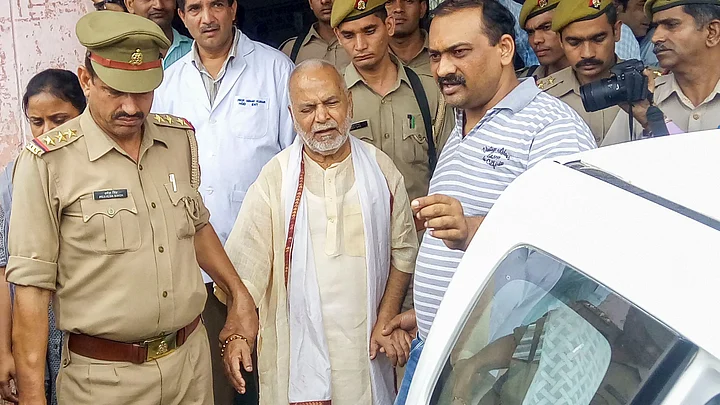Soon after former BJP minister Swami Chinmayanand was arrested by the UP Special Investigating Team (SIT) on Friday, 20 September, it appeared that one of the key concerns with the case had been addressed.
UP DGP, OP Singh, a member of the SIT, announced that after conducting inquiries, including reviewing the 40+ videos submitted by the complainant, “balatkar ka mukadma add kiya hai (rape provisions have been added).”
The SIT had come under strong criticism for failing to do this till now. The investigators were probing the matter on the basis of the allegations originally raised by the complainant’s father (who’d alleged kidnapping and criminal intimidation) as well as the complaint filed by Chinmayanand, accusing her and others of extortion.
However, soon after the DGP’s announcement, Chinmayanand’s lawyer Pooja Singh claimed that no offence of rape had been added, and that instead, the police had booked him for ‘misusing his position of authority to have sexual intercourse, not amounting to rape.’
What Did the Police Actually Book Chinmayanand Under?
Local reporters who had spoken to the SIT also said that the charge of rape had not been added, and that the SIT would investigate it as a possible violation of Section 376C of the Indian Penal Code.
The Quint was able to access a copy of the SIT’s document adding new provisions to the FIR, and was able to confirm that, indeed, the police had not added the offence of rape – which falls under Section 376 of the IPC – to the FIR.
The new provisions added to the FIR were Section 354D (stalking) and Section 376C.

Section 376C’s numbering makes it look like it may be a rape charge, but this is not so. It instead punishes a man who abuses a position of trust or authority to induce a woman to have sexual intercourse with him – “such sexual intercourse not amounting to the offence of rape.”
What Should Have Been Added to the FIR?
The inclusion of Section 376C by the SIT shows that they consider Chinmayanand to have been in a position of authority over the complainant. Since the woman has specifically alleged that he committed rape on her multiple times, this means that the police should have looked to the provisions of Section 376(2) instead, which deals with ‘aggravated rape’.
Supreme Court advocate Vrinda Grover supports this view. Speaking to The Quint, she said:
“To my mind, from the allegations made by the young woman, the provisions that ought to have been attracted to this case are Section 376(2), which is aggravated rape. And within that, there would be three sub-clauses. There’s one about trust or authority. There’s another about control or dominance. And the third one is when there is repeated rape. These are the provisions that should have been attracted.”
The three sub-clauses of Section 376(2) referred to by Grover are:
- Sub-clause (f) – rape by a person in position of trust or authority
- Sub-clause (k) – rape by a man in a position of control or dominance over a woman
- Sub-clause (n) – repeated rape
According to Grover, the failure to add these provisions to the FIR is a “very, very clear dilution of the offences and a weakening of the case.”
How Does Using Section 376C Instead of Section 376(2) Weaken the Case?
Differences in Possible Punishment
Given the aggravated nature of offences under Section 376(2), anyone convicted under any of its sub-clauses faces a minimum jail sentence of 10 years of rigorous imprisonment, and can even be sentenced up to a maximum of life imprisonment.
On the other hand, the minimum sentence under Section 376C is five years rigorous imprisonment, while the maximum sentence is 10 years.
The Presumption of Consent
Section 376C essentially accepts that the woman has consented to the sexual intercourse, having been “seduced” or “induced”. This is why it is not considered rape, which is, of course, defined as sexual intercourse against a woman’s will and without her consent.
Section 376(2), however, covers acts where it is presumed that there was no consent, because of the position of authority/control/trust the man has over the woman. This operates in conjunction with Section 114A of the Indian Evidence Act, as explained by Grover:
“These aggravated rapes are circumstances where the rape is committed in a situation where the woman is in a coercive circumstance. And, therefore, you cannot plead consent. The presumption shifts to the accused if the woman says that she did not consent and that sexual intercourse is proved.”
To sum up, by booking Chinmayanand under Section 376C rather than 376(2), the SIT has ensured that he would not have to deal with the presumption of consent that would apply in this case, since there appears to be ample evidence that there was sexual intercourse, and it is beyond argument that he held a position of authority/trust/control.
It also means that even if he is convicted in this case, he would likely get a sentence lower than the minimum punishment he would get under Section 376(2), and that he definitely can’t get life imprisonment.
Apart from how this appears to be a dilution, it should be noted that this is also wrong on a procedural level. The Supreme Court, in the 2013 Lalita Kumari judgment, had held that if a police officer is made a complaint which discloses a cognisable offence, he has to register an FIR regarding the same immediately.
As the girl has alleged rape specifically (which is a cognisable offence), this had to be added to the FIR. This could later be downgraded to Section 376C at the time of framing of charges, or even during the trial, but not at this time.
(At The Quint, we question everything. Play an active role in shaping our journalism by becoming a member today.)

